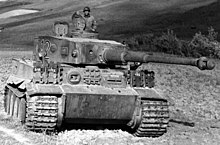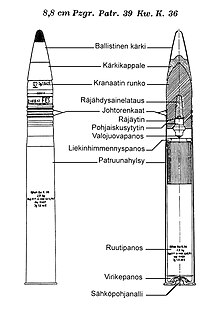This article has multiple issues. Please help improve it or discuss these issues on the talk page. (Learn how and when to remove these messages)
|
| 8.8 cm KwK 36 | |
|---|---|
 A captured Tiger I tank fitted with the 8.8 cm KwK 36 A captured Tiger I tank fitted with the 8.8 cm KwK 36 | |
| Type | Kampfwagenkanone |
| Place of origin | Germany |
| Service history | |
| Used by | Nazi Germany |
| Wars | World War II |
| Production history | |
| Designer | Krupp |
| Unit cost | 18,000 ℛ︁ℳ︁ |
| Specifications | |
| Barrel length | 492.8 cm (194.0 in) bore (56 calibres) |
| Shell | Fixed QF 88 × 571mmR |
| Shell weight | 10.2 kg (22 lb) Pzgr 39 Armor-piercing, capped, ballistic capped shell 7.3 kg (16 lb) Pzgr 40 Armor-piercing composite rigid (APCR) |
| Calibre | 88 mm (3.46 in) |
| Elevation | -8° to +15° |
| Rate of fire | 10 round per minute |
| Muzzle velocity | 780 m/s (2,600 ft/s) APCBC 930 m/s (3,100 ft/s) APCR |
| Maximum firing range | 10,500 m (34,449 ft) |
The 8.8 cm KwK 36 (German: 8,8 cm Kampfwagenkanone 36) was an 88-millimetre (3.5 in) tank gun used by the German Army during World War II. This was the primary armament of the PzKpfw VI Tiger I tank. It was developed and built by Krupp.
Design
The 8.8 cm KwK 36 was derived from the 8.8 cm Flak 36 anti-aircraft gun by adapting/modifying it to the limited space available in tank turrets. Parts of the KwK 36 were built to practically the same design as the 75-millimetre (3.0 in) and 50-millimetre (2.0 in) guns already used in German tanks. The breech ring was square in section and 320 millimetres (13 in) on a side. The breech block was of vertical falling wedge type and operated semi-automatically, meaning that after firing the empty cartridge case was automatically ejected, while the breech cocked itself and remained open, ready to receive the next round.
The "L/56" in the designation is descriptor of barrel length; the ratio of the length of the barrel in proportion to the width of the bore. The designation "L/56" means the barrel is 56 times 88 mm - about 4.9 m (16 ft 1 in). The longer the tube is in relation to its bore, the higher the muzzle velocity it can generate on fixed charge. A longer gun barrel allows the expanding gas from the shell's charge to act on the projectile longer than a short barrel, imparting it more velocity and force. For the Tiger II's 8.8 cm KwK 43 L/71, barrel length is 6.25 m (20 ft 6 in) generating a higher velocity.
Performance

The KwK 36 was very accurate and high-powered, and its high muzzle velocity produced a very flat trajectory. This allowed its gunners a higher margin of error in estimating range.
In British firing trials during the war, a British gunner scored five successive hits from 1,200 yards (1,100 m) at a 16-by-18-inch (41 by 46 cm) target. Another five rounds were fired at targets moving at 15 miles per hour (24 km/h), and, although smoke obscured the gunners' observation, three hits were scored after directions given by the commander. The sighting system resulted in excellent firing accuracy for the 8.8 cm KwK 36 gun on the Tiger I.
Capability
The gun's performance was highly dependent on distance to target and type of ammunition loaded. For kinetic penetration, the speed of the projectile upon impact is crucial, and the cumulative effect of air resistance decreases the velocity of the shell as the distance to the target increases. The accuracy achieved during controlled test firing to determine the pattern of dispersion gives a greater accuracy than the variation expected during practice firing on a range due to differences between guns, ammunition and gunners; both at precisely known distances. Due to errors in estimating the range and many other factors, the probability of a first shot hit under battlefield conditions was much lower than at the firing range. Observing the tracer from the first round in battle, the average, calm gunner might achieve the firing range accuracy shown in the second column with the second round fired at the same target.
This gun used the same size 88 x 571R mm cartridge, with the exception of being electrically primed compared to the percussion primed cases employed by the Flak 18/36/37.
Panzergranate 39 (PzGr. 39)

- Type: Armour-piercing, capped, ballistic cap (APCBC) projectile with explosive filler and tracer.
- Projectile weight: 10.2 kg (22 lb)
- Muzzle velocity: 773 m/s (2,540 ft/s)
- Explosive filler: 0.059 kg (0.13 lb)
- Propellant weight: 2.5 kg (5.5 lb)
| Hit probability versus 2.5 x 2 m target | |||
|---|---|---|---|
| Range | Penetration | Test bed | Firing range |
| 100 m | 132 mm | 100% | 100% |
| 500 m | 110 mm | 100% | 100% |
| 1000 m | 99 mm | 100% | 93% |
| 1500 m | 91 mm | 98% | 74% |
| 2000 m | 83 mm | 87% | 50% |
| 2500 m | n/a | 71% | 31% |
| 3000 m | n/a | 53% | 19% |
PzGr. 40 (APCR)
- Type: Armour-piercing, composite rigid (APCR) projectile had a sub-calibre tungsten carbide core.
- Projectile weight: 7.3 kg (16 lb)
- Muzzle velocity: 930 m/s (3,100 ft/s)
- Propellant weight: 2.85 kg (6.3 lb)
| Hit probability versus 2.5 x 2 m target | |||
|---|---|---|---|
| Range | Penetration | Testbed | Firing range |
| 100 m | 171 mm | 100% | 100% |
| 500 m | 156 mm | 100% | 100% |
| 1000 m | 138 mm | 99% | 80% |
| 1500 m | 123 mm | 89% | 52% |
| 2000 m | 110 mm | 71% | 31% |
| 2500 m | n/a | 55% | 19% |
Hl.39 (HEAT)
- Type: high explosive anti-tank (HEAT) round with a shaped charge.
- Projectile weight: 7.65 kg (16.9 lb)
- Muzzle velocity: 600 m/s (2,000 ft/s)
| Hit probability versus 2.5 x 2m target | |||
|---|---|---|---|
| Range | Penetration | Testbed | Firing range |
| 100 m | 90 mm | 100% | 100% |
| 500 m | 90 mm | 100% | 98% |
| 1000 m | 90 mm | 94% | 62% |
| 1500 m | 90 mm | 72% | 34% |
| 2000 m | 90 mm | 52% | 20% |
Sprgr. L/45 (HE)
- Type: high explosive (HE) round
- Projectile weight: 9 kg (20 lb)
- Explosive filler: 0.9 kg of amatol (3765 Kilojoules)
- Propellant weight: 2.55 kg (5.6 lb)–2.95 kg (6.5 lb)
Penetration comparison
| Ammunition type | Muzzle velocity (m/s) |
Penetration (mm) | ||||||||||
|---|---|---|---|---|---|---|---|---|---|---|---|---|
| 100 m | 250 m | 500 m | 750 m | 1000 m | 1250 m | 1500 m | 2000 m | 2500 m | 3000 m | |||
| PzGr. 39 (APCBC) | 780 m/s (2,600 ft/s) | 162 | 158 | 151 | 144 | 138 | 132 | 126 | 116 | 106 | 97 | |
| PzGr. 40 (APCR) | 930 m/s (3,100 ft/s) | 219 | 212 | 200 | 190 | 179 | 170 | 160 | 143 | 128 | 115 | |
| Hl.39 (HEAT) | 600 m/s (2,000 ft/s) | 110 | 110 | 110 | 110 | 110 | 110 | 110 | 110 | 110 | 110 | |
See also
- 8.8 cm KwK 43 L/71 - the direct successor to this gun, and the one mounted on the Tiger II
- 8.8 cm Flak 18/36/37/41, the prominent anti-aircraft and anti-tank weapon the 8.8 cm KwK 36 is often confused with.
Weapons of comparable role, performance, and era
- British Ordnance QF 17-pounder
- Soviet 85 mm D-5T/ZiS-S-53
- United States 90 mm Gun M3
References
- Green, 2005, p. 121
- ^ Jentz, 1996, p. 9
- ^ H.Dv. 481/60, p. 24
- German Explosive Ordnance (Projectiles and Projectile Fuzes) - Department of the Army Technical Manual TM-9-1985-3. 1953. p. 445 https://archive.org/details/TM9-1985-3.
- Bird, Lorrin Rexford; Livingston, Robert D. (2001). WWII Ballistics: Armor and Gunnery. Overmatch Press. p. 61.
Bibliography
- Green Michael, Panzers at War. London: Zenith Press, 2005. ISBN 0-7603-2152-3
- Thomas L. Jentz, Germany's Tiger Tanks: Tiger I and Tiger II - Combat Tactics. London: Schiffer Publishing, 1996. ISBN 0-7643-0225-6
- H.Dv. 481/60 Merkblatt für die Munition der 8,8 cm Kampfwagenkanone 36
External links
- Information about the Tiger I and its KwK 36 gun at the Tiger I Information Center
- Historical and technical data on the 88 mm FlaK 36 and KwK 36, as well as on the PzKpfw VI Tiger I at the Armorsite
| German artillery of World War II | |
|---|---|
| Tank guns | |
| Anti-tank guns | |
| Infantry and mountain guns | |
| Recoilless guns | |
| Mortars | |
| Heavy mortars | |
| Rocket artillery | |
| Field, medium and heavy guns | |
| Superheavy and siege artillery | |
| Railroad artillery | |
| Naval artillery |
|
| Anti-aircraft guns | |
| Demolition charges | |